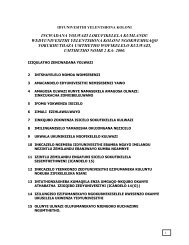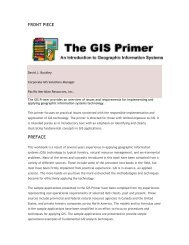Ecosystem Guidelines for Environmental Assessment
Ecosystem Guidelines for Environmental Assessment
Ecosystem Guidelines for Environmental Assessment
Create successful ePaper yourself
Turn your PDF publications into a flip-book with our unique Google optimized e-Paper software.
LOWLAND FYNBOS<br />
INCORPORATING SAND FYNBOS AND LIMESTONE FYNBOS<br />
LOWLAND FYNBOS<br />
ECOSYSTEMS<br />
LOWLAND FYNBOS ECOSYSTEMS<br />
Nick Helme, Pat Holmes and Tony Rebelo<br />
What are the key ecological “drivers” in terms of<br />
maintaining ecosystem function, pattern or structure<br />
Limestone Fynbos and Sand Fynbos often occur in a matrix, and ecological processes that affect the<br />
one may be closely inter-related with the other.<br />
Fire frequency must ensure sufficient seed-set in slow-maturing species such as the Proteaceae.<br />
This can be up to 30 years in arid areas.<br />
The appropriate seasonal fire regime must be retained. Fire should occur in summer to early autumn<br />
(December to March).<br />
Under natural regimes fires are slow moving, ignition is extremely rare (most fires start "elsewhere")<br />
and fires burn unimpeded over large areas. End boundaries of fires are usually other vegetation types<br />
and young veld.<br />
Allow <strong>for</strong> sufficient seed-set in slow-maturing species.<br />
In Limestone Fynbos and Sand Fynbos, there can be a high incidence of species turnover along<br />
habitat or environmental gradients, i.e. beta diversity is high. Many edaphic gradients are found on<br />
edges of Limestone Fynbos and Sand Fynbos communities. Subtle edaphic variations, such as the depth<br />
of overlying sand, have a dramatic effect on community structure. There are also substantial unexplained<br />
variations in species richness, and concentration of rare and endemic plants, from area to area.<br />
Patch size and connectivity with other limestone outcrops may be important to retain certain species.<br />
Seasonal wetlands and seeps are important to retain certain distinct communities. Regional and<br />
local natural water drainage patterns are thus also important drivers of biodiversity pattern.<br />
Natural grazing and physical soil disturbance by fauna may be important to retain a high incidence<br />
of spring annuals, which is unusual in fynbos.<br />
What are the key issues, vulnerabilities and threats<br />
There can be a very high occurrence of rare and regionally endemic plant species in Limestone Fynbos<br />
and Sand Fynbos, many of which are very localised within what might appear to be fairly homogenous<br />
habitat. In Sand Fynbos, the incidence of rare and endemic plant species is particularly high in the<br />
South.<br />
Vulnerable habitats include wetlands, sink-depressions and moister soil facies. These ecotypes are<br />
at risk due to their higher agricultural potential.<br />
Both Limestone Fynbos and Sand Fynbos are vulnerable to changes in the natural fire regime (to<br />
promote grazing, <strong>for</strong> example) and invasion by alien plants.<br />
They are also at risk from veld clearance and ploughing, over-harvesting of species (flowers and<br />
whole plants), and changes in water availability due to abstraction of groundwater.<br />
Limestone Fynbos is highly susceptible to invasion by rooikrans Acacia cyclops, especially on deeper<br />
sands in valleys between rocky outcrops. However, in areas of severe invasion even the rocky pavements<br />
are affected. Besides being vulnerable to rooikrans, Sand Fynbos is also susceptible to invasion by<br />
Port Jackson Acacia saligna, Eucalyptus gomphocephala and Leptospermum laevigatum, and annual<br />
grasses (Avena, Briza).<br />
COLIN PATERSON-JONES<br />
38 : LOWLAND FYNBOS ECOSYSTEMS
















